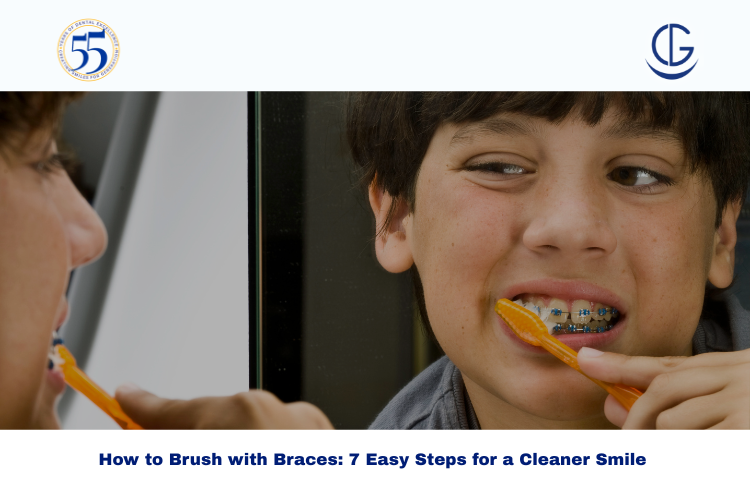Schedule Appointment




Wearing braces is a major step toward achieving a healthy, beautiful smile—but it also means committing to a new level of oral hygiene. Knowing how to brush with braces properly is essential to prevent plaque buildup, cavities, and gum issues during orthodontic treatment. At Dr. Gowds Dental Hospital in Hyderabad, we often see patients struggle with maintaining oral hygiene after getting braces. That’s why we’ve created this guide—to help you navigate brushing, flossing, and protecting your smile every day.
Braces create many new surfaces and small crevices where food particles and bacteria can hide. This makes brushing more challenging—and more important. Without proper cleaning, you risk tooth decay, enamel discoloration, and inflamed gums.
Before brushing, rinse your mouth thoroughly with water. This loosens food debris and makes brushing more effective.
Use a soft-bristled toothbrush or an orthodontic toothbrush with V-shaped bristles. Electric toothbrushes can also be effective, as they clean more efficiently around brackets and wires.
Fluoride strengthens enamel and helps prevent cavities. Apply a pea-sized amount to your brush.
Hold your toothbrush at a 45-degree angle. Brush above the brackets, then angle the brush below the brackets. This ensures you clean the entire surface of your teeth and around the braces.
Spend about 10 seconds per tooth. Be gentle but thorough—especially around the brackets and wires.
Brush your gums with a circular motion to stimulate them and remove plaque. Also, gently brush your tongue to reduce bacteria and freshen breath.
Use a fluoride mouthwash for added protection, especially if you’re prone to cavities.
Flossing is trickier with braces, but it’s still crucial. Use:
Floss at least once a day to remove plaque from between teeth where brushing can’t reach.
These tiny brushes slide between teeth and around brackets to remove plaque.
Candy, soda, gum, and starchy foods can cause plaque buildup and damage wires.
Regular check-ups allow your orthodontist to adjust your braces and check for signs of decay or inflammation.
While brushing with braces is key, a few natural remedies can help support oral hygiene.
Benefits: Reduces inflammation, soothes mouth sores.
How to Use: Mix 1/2 tsp of salt in warm water. Swish for 30 seconds after brushing.
Precaution: Don’t overuse; it can dry out your mouth.
Benefits: Neutralizes acids and gently whitens.
How to Use: Mix a small amount of baking soda with water to make a paste. Brush gently once a week.
Precaution: Avoid daily use—it can erode enamel.
Benefits: Soothes irritation from brackets.
How to Use: Apply to gums or inner cheeks after brushing.
Precaution: Make sure it’s pure aloe without added ingredients.
Benefits: Natural pain relief for sore spots.
How to Use: Dab a little on a cotton swab and apply to sensitive areas.
Precaution: Use sparingly and avoid swallowing.
If you experience persistent pain, bleeding gums, or white spots on your teeth, contact your orthodontist or dentist right away. These could be signs of a bigger issue that regular brushing can’t fix. The team at Dr. Gowds Dental Hospital in Hyderabad offers comprehensive orthodontic and dental care—because your health matters just as much as your smile.
Learning how to brush with braces may seem challenging at first, but with the right tools, techniques, and support, you can keep your teeth clean and your treatment on track. Use soft brushes, floss daily, and incorporate natural remedies like saltwater rinses or aloe vera for added comfort.
Most importantly, don’t hesitate to reach out to your orthodontist if you have concerns. And if you’re in Hyderabad, the experts at Dr. Gowds Dental Hospital are here to help you every step of the way.
You should brush at least twice a day, ideally after every meal, to keep food and plaque from building up around your braces.
Yes, but it’s best to use a soft-bristled or orthodontic toothbrush for better access around the brackets and wires.
Improper brushing can lead to cavities, gum disease, bad breath, and white spots on your teeth once the braces are removed.
Check your teeth and brackets after brushing. If you still see food particles or feel a fuzzy coating on your teeth, you may need to adjust your technique.
Absolutely! Dr. Gowds Dental Hospital in Hyderabad offers personalized oral care tips, brushing demos, and product recommendations for all orthodontic patients.